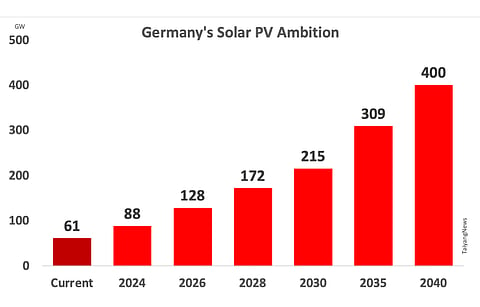

German Federal Parliament Bundestag has approved its Easter Package paving the way for the country to aim for 215 GW cumulative installed solar PV capacity by 2030, as proposed by the government coalition earlier, and take it to 400 GW by 2040.
Back in April 2022 when the cabinet passed the Easter Package, the Ministry for Economic Affairs and Climate Action (BMWK) had been aiming for a cumulative of 215 GW of solar by the end of 2030 (see German Government Agrees On Higher 2030 Solar Goal Of 215 GW).
Now there is far more clarity on the annual numbers the government entrusts solar PV industry aims to achieve, supported by the Renewable Energy Sources (EEG) 2023. Under the expansion path specified, Germany will aim for 88 GW solar by 2024, 128 GW by 2026, 172 GW by 2028, 215 GW by 2030, 309 GW by 2035 and 400 GW by 2040. That means Germany will have to install around 18 GW per year, that's close to what the EU-27 installed in 2020 combined.
For onshore wind energy, the cumulative capacity should reach up to 160 GW by 2040, and for offshore 70 GW by 2045.
The new version of the Easter Package includes separate subsidy category for agrivoltaics, floating solar and moor PV. Solar installations as usable PV shoulders on federal motorways and railways will be extended to 500 meters, from earlier 200 meters.
The overarching aim is to have renewables account for 750 TWh of renewable energy capacity in the gross electricity consumption by 2030, and 80% of the national electricity mix. Coal phase out timing remains the same for 2035.
FIT rates increased
The following rates will be applicable once the proposals come into force officially. These will be valid for those owners who decide to consume solar energy generated, and sell remaining to the grid.
In case the system owners decide not to consume any solar energy generated through their system of up to 10 kW capacity, they will be eligible for €0.048 per kWh FIT, which will be down from €0.0687 per kWh in the present system.
For tenant electricity systems, the size limit of 100 kW has been abolished.
German solar energy association BSW-Solar welcomed the passing of EEG A2023 as an important milestone en route the solar age. "These correct and unalterable goals can only be achieved if investment barriers are now consistently torn down and further reform packages follow quickly," said BSW Managing Director Carsten Körnig.
